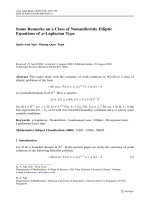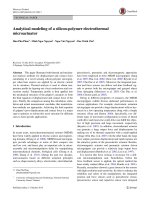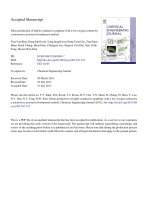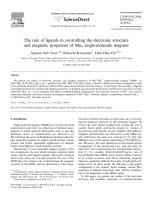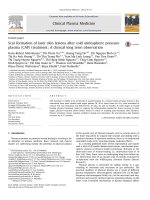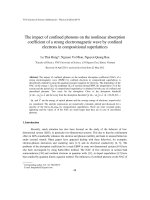DSpace at VNU: Electronic Structure of a Molecular Magnet from Salicylate Based Copper Complex
Bạn đang xem bản rút gọn của tài liệu. Xem và tải ngay bản đầy đủ của tài liệu tại đây (1.23 MB, 6 trang )
VNU Journal of Science, Mathematics - Physics 28 (2012) 26-31
Electronic Structure of a Molecular Magnet from Salicylate
Based Copper Complex
Nguyen Duc Tho1, Nguyen Thuy Trang1, Hoang Nam Nhat1,*
1
VNU University of Engineering and Technology,
144 Xuan Thuy, Cau Giay, Hanoi, Vietnam
Received 14 September 2012, received in revised form 02 October 2012
Abstract. The electronic structure of the metallo-organic compound Cu(SA)2(2-PM)2 (2-PM is 2pyridylmethanol) is presented. The calculation was performed using the Density Functional
Theory with unrestricted spin polarized model and large wave function basis sets which include
the polarized and diffuse functions. The single point energy calculation for the isolated molecule
gave the HOMO-LUMO separation of 3.8 eV and the LDA+U band structure calculation showed
the band gap of only 0.38 eV. The calculated magnetic moment per molecule is comparable to the
experimentally observed value.
Keywords: Molecular magnet, DFT, Electronic structure
1. Introduction∗
Salicylic acid (SA) in the form of C6H4(OH)COOH is a natural extract from the bark of the willow
tree (salix in Latin). It is commonly referred to as a plant hormone due to numerous functions that this
compound expresses on the growth and development of plants such as active photosynthesis,
chloroplast, ion uptake and endogenic signaling [1]. The derivatives of the SA are widely involved in
drugs, e.g. acetylsalicylic acid (aspirin), methyl salicylate (against muscle pain) etc. Since the SA is
poorly soluble in water, the pyridine (C5H5N) is often used as a solvent in chemical synthesis. In the
presence of Cu2+ cations, the metal complex in the form of Cu[SA]2[pyridine]2 can be created. These
structures have been synthesized for the purpose of introducing the new drug categories with
controlled releasing mechanism [2]. Recently, these materials have received renewed interest because
they have been found to behave as a molecular magnet with the net magnetic moment of nearly 1µB /
molecule [3]. No microscopic study, however, has been made to provide physical insights into the
electronic structure of the material. In this work, we report the ab initio study of the electronic
structure of Cu[SA]2(2-PM)2.
_______
∗
Corresponding author.: Email:
26
N.D. Tho et al. / VNU Journal of Science, Mathematics - Physics 28 (2012) 26-31
27
2. Experimental
The Cu(SA)2(2-PM)2 (2-PM is 2-pyridylmethanol) has been prepared using the same procedure as
reported in Ref. [2], i.e. by mixing of a 0.02M solution of 2-PM with a 0.01M solution of Cu(II)
salicylate in continuous stirring in hot methanol. The solution was then left to crystallize from the
methanol at room temperature, yielding a prismatic monocrystal of average dimension 0.25 × 0.70 ×
0.80 mm. The relative difference between the measured (Dm) and calculated (Dc) density |Dc−Dm|/Dm
was less than 0.7%. The compound crystallized in a monoclinic space group C2/c (no.15) with
following lattice parameters a = 15.79, b = 13.30 and c = 12.08 Ǻ (β = 97.2o). The crystal structure,
including unit packing and atomic positions, was determined on the basis of single crystal diffraction
technique using CuKα radiation (the structural calculation was provided by SHELX-97 software [4]).
A total of 3500 diffractions was obtained at room temperature, the maximal hkl indices were (−16,16),
(0,14) and (0,12) respectively. The final R-factor was below 4 %. Fig.1 shows the unit packing (a) and
the molecular geometry of Cu(SA)2(2-PM)2 (b).
3. Method of calculation
The Cu(SA)2(2-PM)2 is quite large system for ab initio calculation. A single molecule
(Cu1C26H24O8) contains 59 atoms and a unit cell 4-times such amount, i.e. 236 in total. For the periodic
structure calculation, the minimal set of atomic orbitals should account for 4 Cu, 104 C, 96 H and 32
O atoms. The time comsumption of the calculation naturally depends also on the size of k-vector, size
of wave functions, energy or dimension cut-offs, spin model (restricted versus unrestricted spin
polarized model) and additional factors. Therefore, to reduce the complexity of the computational task,
the appropriate model chemistry should be chosen. However, several factors cannot be simplified, as
the Cu(SA)2(2-PM)2 possesses two important electronic properties: (i) it has a doublet ground state
due to Cu2+ 3d9 electronic configuration; (ii) it is expected to be driven by a strong electron-correlation
in the Cu-O bonding octahedron. Furthermore, as commonly expected for the metallo-organic
compounds containing the benzoyl ring, the molecular orbitals (MO) representing the π−π system of
the benzoyl ring usually occur as the highest occupied molecular orbital (HOMO), or just immediately
below this level. Therefore, the electronic structure of the Cu(SA)2(2-PM)2 was computed in this study
with the following settings: (i) the spin model is locked as unrestricted spin-polarized; (ii) the minimal
atomic orbital basis set contain polarized and diffuse function; (iii) a reference LDA+U band structure
calculation was computed. The used softwares: the Gaussian code [5] was used for the single point
(SP) energy calculation for a single molecule; the DMol3 code [6] was applied for the periodic
structure calculation and the CASTEP code [7] was exploited to obtained the LDA+U band-structure.
28
N.D. Tho et al. / VNU Journal of Science, Mathematics - Physics 28 (2012) 26-31
Fig.1. The unit cell packing (a) and the molecular structure (b) of Cu(SA)2(2-PM)2.
4. Results and discussion
The SP results envolved a total of 624 basis functions (1208 primitive Gaussian and 627 cartesian
basis functions) for 144 alpha and 143 beta electrons, at the level theory (model chemistry)
DFT/UB3LYP/6-31G(d) (Density Functional Theory with Beck's style hybrid functional and
unrestricted spin model on a relatively large basis set). The convergence was excellent and we have
obtained the correct doublet spin ground state energy, E(UB+HF-LYP) = −3356.70960979 Hartrees
(Ha), only after 12 cycles of optimization. The HOMO is -0.195 Ha and the lowest unoccupied
molecular orbital (LUMO) is -0.056 Ha (Fig.2). As a result, there is a large HOMO-LUMO gap 0.139
Ha (3.8 eV), corresponding to a similar gap in the band-structure (Fig.3). Over Cu2+, the Mulliken
charge is 0.85 and Mulliken spin density 0.73. The molecule shows no dipole moment but has the
quadrupole moment. Only Cu atoms show the non-zeroed spin-dipole coupling. There is a 2.7 Gauss
(7.5 MHz) splitting of the hyperfine spin coupling of the 63Cu EPR resonance expected. The analysis
of the Natural Bond Orbitals (NBO) shows the total Cu2+ 3d9 density is 9.17, of which the density of
3dyz electrons is 1.42, and dxy 1.82, whereas all other 3d-electron densities are near 2.0. A part of the
Cu2+ valence electrons occupies the 4s level (0.34), 4p (0.38, of which px is 0.12, py 0.13 and pz 0.13).
The NBO charge over Cu is +1.1 with 18 core electrons and 9.9 valence ones. The NBO electronic
configuration for Cu is [core]4s(0.34)3d(9.16)4p(0.38) (of which the 3d alpha and beta contribute 4.95
and 4.21 respectively). The lack of 1 beta electron induced a lower occupation of the 3dyz level (0.42)
and the fact that those 3dyz electrons exhibit a highest energy among the 3d electrons. The occupation
and energy for the Cu 3d beta (spin down) electrons are listed as follows: 3dz2 (0.99, -0.292) < 3dx2-y2
(0.99, -0.284) < 3dxz (0.99, -0.276) < 3dxy (0.83, -0.246) < 3dyz (0.42, -0.161). There is about 2.2eV
N.D. Tho et al. / VNU Journal of Science, Mathematics - Physics 28 (2012) 26-31
29
separation between the 3dyz and the remaining beta electrons. The lower distribution of charge over the
Cu site than the nominal value 2+ agrees with the positive densities of the Cu 4s and 4p electrons.
However, this does not automatically imply that the oxidation state of Cu is rather 1+ than 2+, since
the calculated densities may be the false results of the dynamic charge relocation between the Cu 3d4s levels as experimentally observed in some copper oxide compounds (e.g. CuO2 in Ref. [8]). The
difference between the spin densities of alpha and beta electrons (0.58) is somewhat lower than the
experimentally detected magnetic moment µB per molecule (0.74) [3].
Fig.2. (Color online). The HOMO, LUMO and some other MO-s for Cu(SA)2(2-PM)2.
The spectral computation of IR spectroscopy showed that the free molecule Cu(SA)2(2-PM)2
exhibits a characteristic IR-active vibration of the carboxyl carbon (C=O resonance) in the static host
lattice of the rest atoms at 1810 cm-1. Another typical vibration is from the hydrogen of the methyl
hydroxyl group at 4095 cm-1 (O-H resonance). The nuclear magnetic resonance (NMR) 13C chemical
shift for the carboxyl carbon showed the largest value of 149.4 ppm with respect to TMS among the
rest carbon atoms. The relatively large 1H chemical shift also demonstated the methyl hydroxyl
hydrogen (5.0 ppm).
30
N.D. Tho et al. / VNU Journal of Science, Mathematics - Physics 28 (2012) 26-31
Fig.3. (Color online). Band structure (a) and density of state (b) of Cu(SA)2(2-PM)2.
The periodic structure calculation was performed with GGA/BLYP functional with a doublenumeric wave function basis set DNP 3.5 (which contains polarized and diffuse function). The orbital
cut-off was set at 4.4Å. The core treatment followed the Effective Core Potentials (ECP) method and
the SCF (self-consistent-field) tolerance was set at 10-5. A medium size k vector was used. Fig. 3(b)
shows the band structure, which is comparable to the one obtained by the DNP basis set using DMol3
code. From this figure the band gap of 0.38 eV was deduced. Fig.3(a) shows the obtained density of
state (DOS). The band structure was computed using the LDA+U correction for the Cu 3d electron
Coulomb repulsion (U=3.5eV).
5. Conclusion
The ferromagnetic ground state was observed for the Cu(SA)2(2-PM)2 with molecular magnetic
moment of order 0.58µB. This lower value compared to the observed one may be associated with the
dynamic hopping of Cu 3d electrons. The band-structure showed the small band-gap of 0.38 eV which
is in sharp contrast to 3.8 eV HOMO-LUMO separation. This signified the important role of the intermolecular hydrogen bonding system which forms the unit cell packing in modifying the
semiconductor band-gap.
Acknowledgments. The authors would like to thank the QGTD 09.04 project from VNU HN and
National Foundation for Science and Technology Development, Vietnam (NAFOSTED) for financial
supports (Project Nanofluids and application, 2009, code 103.02.19.09).
N.D. Tho et al. / VNU Journal of Science, Mathematics - Physics 28 (2012) 26-31
31
Rreferences
[1]
[2]
[3]
[4]
[5]
S. Hayat, A. Ahmad (2007). Salicylic acid - A Plant Hormone. Springer. ISBN 1402051832.
N.N. Hoang, F. Valach, M. Dunaj-Jurco and M. Melnik. Acta Cryst. C48 (1992) 443.
N.N. Hoang. Unpublished data (2010).
G. M. Sheldrick. Acta Cryst. A64 (2008), 112.
M. J. Frisch, G. W. Trucks, H. B. Schlegel et al., Gaussian 03, Revision B.03, Gaussian, Inc., Pittsburgh PA,
2003.
[6] B. Delley, J. Chem. Phys. 92, 508 (1990); Int. J. Quant. Chem. 69, 423 (1998); J. Chem. Phys. 113, 7756 (2000);
A. Kessi and B. Delley, Int. J. Quant. Chem. 68, 135 (1998) (DMol3 code).
[7] S. J. Clark, M. D. Segall, C. J. Pickard, P. J. Hasnip, M. J. Probert, K. Refson, M. C. Payne, Zeitschrift für
Kristallographie 220 (5-6) 567 (2005). (Castep code).
[8] J. M. Zuo, M. Kim, M. O’Keeffe and J.C.H. Spence, Nature 401, 49 (1999).



